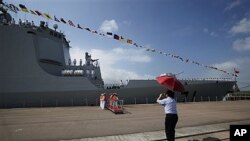The Yuncheng 571 frigate docks at Hong Kong's Victoria harbor for a five-day visit, and following just behind is the Haikou 171 destroyer.
The vessels, two of the Chinese Navy's most advanced warships and part of the 10th Chinese Naval Escort Task Force, are making a port call to celebrate the15th anniversary of the handover of Hong Kong from Britain to China.
Their arrival at Ngong Shuen Chau, the Naval Base also known as the Stonecutters Island, which sits just off the harbor's western entrance, comes at a time of rising tension in the South China Sea.
The current standoff between China and the Philippines is but the latest in a series of maritime incidents between Beijing and its Southeast Asian neighbors, and a new report from security analysts at the International Crisis Group (ICG) confirms the trend of increasing militarization.
"In China, the South Sea Fleet, which is the one responsible for the South China Sea, has traditionally been the least well-endowed of all the three fleets," says Stephanie Kleine-Ahlbrandt, ICG's project director for Northeast Asia. "And so these tensions in the South China Sea are the perfect justification for their modernization."
The 3.5-million square kilometers of the South China Sea are variously contested by China, Malaysia, the Philippines, Brunei and Vietnam.
Last year Vietnam accused Chinese patrol boats of interfering with one of its oil and gas survey ships. Tensions between China and the Philippines, however, have soared because of a set of disputed islands known in English as the Scarborough shoal.
Last week, the United States and the Philippines held joint live-fire naval drills, prompting China to warn Washington against getting involved in the region. But on the eve of a visit to Beijing, U.S. Secretary of State Hillary Clinton insisted Washington is not taking sides.
"As a Pacific power we have a national interest in freedom of navigation, the maintenance of peace and stability, respect for international law," she said.
But ICG analysts say the lack of legal clarity about competing territorial claims is central to the rising tensions.
Steven Tsang, director of the China Policy Institute at the University of Nottingham, suggests China may have wider strategic aims.
"What [officials in Beijing] really are after is not so much the territorial bit, but to be able to basically get the region to accept that it is the Chinese sphere of influence, that they will all accept Chinese leadership or pre-eminence in that part," says professor Tsang. "They would then wish the Americans not to be so deeply involved, [such] that [the South China Sea] would become almost a Chinese lake."
Chinese officials say they plan to present a maritime border claim based on the United Nations Convention on the Law of the Sea. But with such strategically important and resource-rich waters, analysts say finding agreement between so many competing nations will be difficult.






